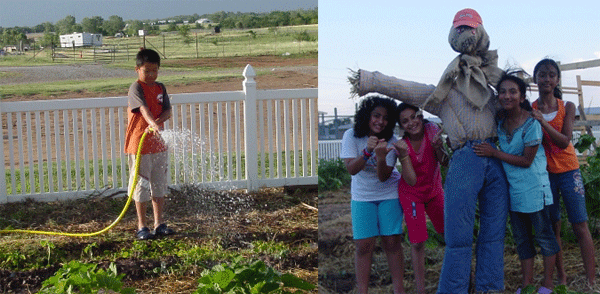 |
December 2012
|
December 2012 // Volume 50 // Number 6 // Ideas at Work // v50-6iw4
Eat, Grow, Lead 4-H: An Innovative Approach to Deliver Campus-Based Field Experiences to Pre-Entry Extension Educators
Abstract
Eat, Grow, Lead 4-H Club was created as a pilot program for college students seeking to gain experience as non-formal youth educators, specifically serving pre-entry level Extension educators through a university-based 4-H club. Seventeen student volunteers contributed an estimated 630 hours of service to the club during spring 2011. The club served 23 children of students living in on-campus housing at Oklahoma State University. The primary purpose for sharing this "idea at work? is to encourage university faculty to create similar programs to serve college students seeking careers as Extension educators.
Introduction
Serving pre-entry Extension educators is a hot topic in need of additional exploration (Benge, Harder, & Carter, 2011; Diem, 2009; Seevers & Dormody, 2010; Scheer, Ferrari, Earnest, & Connors, 2006). Seevers and Dormody (2010) advocate for early field experiences stating “the most motivated youth start early on a pathway to become an Extension agent” (p. 4). Similarly, Scott et. al. (2006) recommended 80 hours of field experience prior to college students serving as Extension interns.
Just who are these “pre-entry” educators? Benge et. al. (2011) described them as individuals seeking or planning to seek employment in Extension. In most cases they are college students looking forward to graduation and their first full-time job.
Faculty at Oklahoma State University pondered their role in this pre-entry stage of development. They concluded that the majority of their students intending to work for Extension complete an internship in Extension; however, an earlier “hands-on” opportunity for students was needed. Borrowing from the literature on preparing future educators (NCATE, 2008), Oklahoma State University created an innovative early field experience for students seeking to prepare themselves as Extension educators in the form of a campus-based, student-led, 4-H club.
Eat, Grow, Lead 4-H Club
To meet the needs of pre-entry Extension educators, Agricultural Leadership faculty, state 4-H leaders, and local county Extension educators agreed to create a campus-based 4-H club that would be led by and serve university students planning to pursue careers in Extension education.
In deciding who to target as members of this new campus-based 4-H club, faculty approached the staff of the university’s Family Resources Center (FRC). The FRC serves over 600 families of graduate and professional students (mostly international students) living in university housing. The FRC already provided an afterschool program for children ages five to fourteen, but was having trouble keeping middle school age children engaged in their after-school activities.
It was decided that the new 4-H club would invite children (ages 9-14) living in university housing to be club members. In support of the program, the FRC offered to provide a meeting room, kitchen facilities, garden space (Figure 1), and a $60 per month budget for meeting supplies. In addition to resources provided by the FRC and Agricultural Leadership Unit, the new 4-H club was supported by a $500 grant from Youth Service America and several local businesses.
Figure 1.
Garden Plots Provided by the University’s Family Resource Center

The goal of the program was for undergraduate and graduate pre-entry Extension educators to take full responsibility for the 4-H club. Students would plan and execute programming under the supervision of two Agricultural Leadership faculty. Toward this goal, four student teams were created: Club, Eat, Grow, and Lead. Each team took on the responsibility of coordinating, designing and implementing monthly 4-H club meetings (Table 1) under faculty guidance. The students named their new campus-based club, the Eat, Grow, Lead 4-H Club.
| Club Logo | Monthly Meeting | Primary Focus |

|
Club: 1st week of the month | 4-H Traditions and Purpose |
| Eat: 2nd week of the month | Nutrition, Healthy Living, and Cooking | |
| Grow: 3rd week of the month | Gardening and Related Lessons | |
| Lead: 4th week of the month | Personal Leadership Development |
Results to Date and Future Plans
Seventeen student volunteers contributed over 600 hours of service to the club during the first semester. Volunteers planned and implemented lessons and activities for fifteen weekly club meetings, and six to 10 volunteers participated in each weekly club meeting (Figure 2). Faculty contributed an average of 12 hours each week to supervising curriculum development and other student led activities.
Figure 2.
College Student Volunteer Leaders Work with Eat, Grow, Lead 4-H Club Members

Impacts of the campus-based pre-entry program included the following.
- College student volunteers experienced being a 4-H Volunteer Leader and program planner, helping them to prepare as future Extension educators. Cooper and Graham (2001) posit that Extension work is less about the technical skills one possesses and more about the ability to manage and train volunteers; furthermore, program planning as a competency was rated highest by both county agents and Extension supervisors.
- College student volunteers were positively affected by the opportunity to work with children from the university community. Because the majority of our 4-H club members have parents born outside the United States of America, the program successfully provided an opportunity for pre-entry Extension educators to gain experience working with a diverse audience, which was recommended by Selby, Peters, Sammons, Branson, and Balschweid (2005).
- Finally, the children who participated as club members demonstrated potential leadership qualities and developed an interest in not only gardening and nutrition, but also in leadership and future community service supporting the mission of 4-H.
Recommendations for Program Replication
Recommendations for universities interested in replicating the program include the following.
- Involve students in all aspects of the club development, including curriculum development, program planning, and volunteer management.
- Seek support from stakeholders, including your county and state Extension offices and campus-based resources.
- Consider targeting children living in university housing, especially if your campus serves an international population. The opportunity to work with such a diverse audience was immeasurable.
- Have all student volunteers complete the county’s volunteer leader application.
- Keep at the forefront of all decisions the intent of the program, service to pre-entry level Extension educators.
Implications
Preparing pre-entry level Extension educators served as the primary focus of this project. Student volunteers came to the Eat, Grow, Lead 4-H Club for the educational experience, and more than half of the volunteers have since pursued internships and/or careers in Extension. Other volunteers decided that a career in Extension was not for them. Eat, Grow, Lead 4-H Club as a field experience for pre-entry Extension educators indicates that a campus-based, faculty-directed environment is one way to meet the needs of pre-entry Extension educators. Specifically, it allows the pre-entry Extension educator to explore and prepare for Extension as a career prior to taking on the full-time role of an Extension educator.
References
Benge, M., Harder, A., & Carter, H. (2011). Necessary pre-entry competencies as perceived by Florida Extension agents. Journal of Extension [On-line]. 49(5) Article 5FEA2. Available at: http://www.joe.org/joe/2011october/a2.php
Cooper, A. W., & Graham, D. L. (2001). Competencies needed to be successful county agents and county supervisors. Journal of Extension [On-line], 39(1) Article 1RIB3. Available at: http://www.joe.org/joe/2001february/rb3.php
Diem, K. G. (2009). Preparing youth development professionals to be successful: How do the needs of extension/4-H compare to those of other organizations? Journal of Extension [On-line], 47(1) Article 1RIB1. Available at: http://www.joe.org/joe/2009february/rb1.php
NCATE: The Standard of Excellence in Teacher Preparation. (2008). Unit standards in effect 2008. Retrieved from: http://www.ncate.org/Standards/NCATEUnitStandards/UnitStandardsinEffect2008/tabid/476/Default.aspx#stnd3
Scheer, S. D., Ferrari, T. M., Earnest, G. W., & Connors, J. J. (2006). Preparing Extension professionals: The Ohio State University's model of Extension education. Journal of Extension [On-line], 44 (4) Article 4FEA1. Available at: http://www.joe.org/joe/2006august/a1.php
Selby, K. A., Peters, J. L., Sammons, D. J., Branson, F. F., & Balschweid, M. A. (2005). Preparing Extension educators for a global community. Journal of Extension [On-line], 43(4) Article 4RIB1. Available at: http://www.joe.org/joe/2005august/rb1.php
Seevers, B., & Dormody, T. J. (2010). Turning an Extension aide into an Extension agent. Journal of Extension [On-line], 48(6) Article 6IAW1. Available at: http://www.joe.org/joe/2010december/iw1.php




